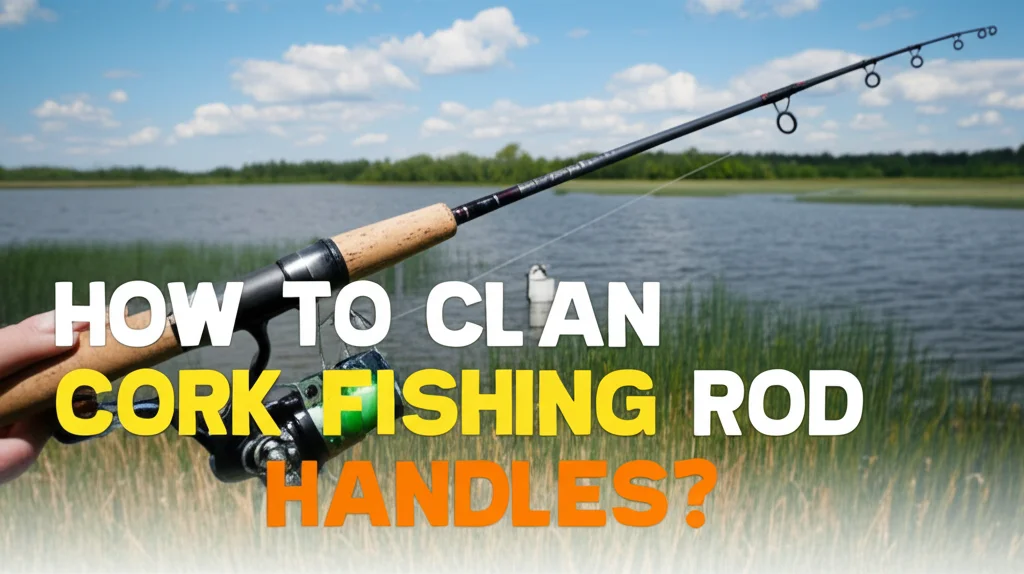· Outdoors & Recreation · 7 min read
How To Clean Cork Fishing Rod Handles?

How to Clean Cork Fishing Rod Handles: A Step-by-Step Guide
Have you noticed your fishing rod handle feeling grimy or losing its grip? A dirty cork handle can really impact your fishing experience. Cleaning your cork handle isn’t just about aesthetics; it’s about maintaining a secure grip and extending the life of your valuable fishing gear. This article will walk you through everything you need to know about how to clean cork fishing rod handles, ensuring they stay in prime condition for years to come. We’ll cover the best methods, tools, and preventative measures to keep your rod feeling like new.
Takeaway:
- Regular cleaning prevents dirt buildup and maintains grip.
- Mild soap and water are usually sufficient for routine cleaning.
- Avoid harsh chemicals that can damage the cork.
- Proper drying is crucial to prevent mold and mildew.
Quick Answer:
To clean cork fishing rod handles, gently scrub with mild dish soap and lukewarm water using a soft brush or cloth. Rinse thoroughly and allow to air dry completely, avoiding direct sunlight. This simple process removes dirt and grime, restoring grip and extending the handle’s lifespan.
Why Cleaning Your Cork Handle Matters
Cork handles aren’t just comfortable; they provide a crucial connection between you and your catch. Over time, they accumulate dirt, oils from your hands, and even algae, which can make them slippery and uncomfortable. A compromised grip can lead to missed strikes and even lost fish. Regular cleaning ensures optimal performance and prevents long-term damage to the cork. Think of it as a small investment in a much larger enjoyment of your hobby.
Beyond grip, dirt and grime can actually degrade the cork over time. The porous nature of cork means it absorbs these substances, potentially leading to discoloration and weakening of the material. Keeping your handle clean helps preserve its integrity and prevents costly repairs or replacements.
Gathering Your Cleaning Supplies
Before you start, it’s important to have the right tools on hand. You don’t need anything fancy, but using the correct supplies will make the job easier and prevent damage. Here’s what you’ll need:
- Mild Dish Soap: Avoid harsh detergents or abrasive cleaners.
- Lukewarm Water: Hot water can damage the cork.
- Soft Brush: An old toothbrush works perfectly.
- Soft Cloths: Microfiber cloths are ideal.
- Optional: Cork Conditioner: For deeper cleaning and restoration.
- Optional: Cotton Swabs: For reaching tight spaces.
Having these items ready will streamline the cleaning process and ensure you have everything you need to get the job done right. Don’t underestimate the power of a soft brush – it’s your primary tool for lifting dirt without causing abrasion.
The Basic Cleaning Process: Soap and Water
This is the go-to method for routine cleaning and is suitable for most cork handles. It’s simple, effective, and won’t damage the material.
- Prepare the Solution: Mix a small amount of mild dish soap with lukewarm water.
- Apply to Handle: Dip your soft brush into the soapy water and gently scrub the cork handle. Work in circular motions, paying attention to areas with visible dirt.
- Rinse Thoroughly: Use clean, lukewarm water to rinse away all traces of soap. Ensure no soap residue remains, as it can attract dirt.
- Dry Completely: Use a clean, dry cloth to wipe down the handle. Allow it to air dry completely before storing or using your rod. Avoid direct sunlight or heat, as this can cause the cork to dry out and crack.
This method is perfect for after a day on the water, removing salt, grime, and oils before they have a chance to set in. Remember, gentle is key – you’re cleaning, not scouring! If you’re looking for more information on keeping your floors clean, check out https://www.beacleaner.com/how-to-clean-vinyl-plank-flooring/ for tips on maintaining various surfaces.
Dealing with Stubborn Dirt and Grime
Sometimes, soap and water aren’t enough to tackle stubborn dirt or grime. Here are a few techniques to try:
- Baking Soda Paste: Mix baking soda with a small amount of water to create a paste. Gently apply to the affected area and scrub with a soft brush. Rinse thoroughly.
- Magic Eraser (Use with Caution): Magic Erasers are mildly abrasive. Test in an inconspicuous area first. Gently rub the dirty area, then rinse thoroughly.
- Cork Conditioner: A dedicated cork conditioner can help lift dirt and restore the cork’s natural oils. Follow the product instructions carefully.
Always test any cleaning solution in a small, hidden area of the handle before applying it to the entire surface. This will help ensure it doesn’t cause any discoloration or damage.
Deep Cleaning and Restoration with Cork Conditioner
For cork handles that are heavily soiled or showing signs of wear, a deep cleaning with cork conditioner is recommended. Cork conditioner helps to rehydrate the cork, remove embedded dirt, and restore its natural luster.
- Clean First: Begin by cleaning the handle with mild soap and water as described above.
- Apply Conditioner: Apply a small amount of cork conditioner to a clean cloth.
- Work it In: Gently rub the conditioner into the cork handle, working in circular motions.
- Let it Sit: Allow the conditioner to sit for the time recommended on the product label.
- Buff and Dry: Buff the handle with a clean, dry cloth to remove any excess conditioner.
Using a cork conditioner periodically can significantly extend the life of your handle and keep it looking and feeling its best. It’s like giving your cork handle a spa day! If you’re concerned about residue from cleaning products, you might find this article helpful: https://www.beacleaner.com/how-to-remove-baking-soda-residue-from-carpet/.
Preventing Future Dirt Buildup
Prevention is always better than cure. Here are a few tips to help keep your cork handle clean and in good condition:
- Wash Your Hands: Before handling your rod, wash your hands to remove oils and dirt.
- Rinse After Use: After each fishing trip, rinse your rod with fresh water to remove salt, grime, and algae.
- Store Properly: Store your rod in a case or rack to protect it from dust and damage.
- Regular Cleaning: Make cleaning your cork handle a part of your regular fishing gear maintenance routine.
By following these simple steps, you can significantly reduce the amount of dirt buildup and keep your handle in top condition. A little preventative care goes a long way! Maintaining your gear is similar to maintaining your home; you can find helpful tips on floor care here: https://www.beacleaner.com/how-to-clean-hardwood-floors-with-vinegar/.
Frequently Asked Questions (FAQ)
Q: Can I use alcohol to clean my cork handle?
A: No, alcohol can dry out and damage the cork. Stick to mild soap and water or a dedicated cork conditioner.
Q: How often should I clean my cork handle?
A: It depends on how often you fish. After each use is ideal, but at least once a month is recommended.
Q: What if my cork handle is stained?
A: Try a cork conditioner or a baking soda paste. If the stain persists, consult a professional rod repair service.
Q: Can I use a pressure washer to clean my fishing rod?
A: Absolutely not! A pressure washer will damage the cork and other components of your rod.
Q: Is it okay to use a scrub brush on my cork handle?
A: Avoid using abrasive scrub brushes, as they can damage the cork. Opt for a soft brush, like an old toothbrush.
Conclusion
Cleaning your cork fishing rod handles is a simple yet crucial part of maintaining your fishing gear. By following the steps outlined in this guide, you can keep your handles clean, grippy, and in excellent condition for years to come. Remember to use mild cleaning solutions, avoid harsh chemicals, and prioritize gentle scrubbing. Regular cleaning not only improves your fishing experience but also extends the life of your valuable equipment. So, take a few minutes to show your cork handles some love – your fish will thank you! For more cleaning tips and tricks, explore our other articles at https://www.beacleaner.com.




